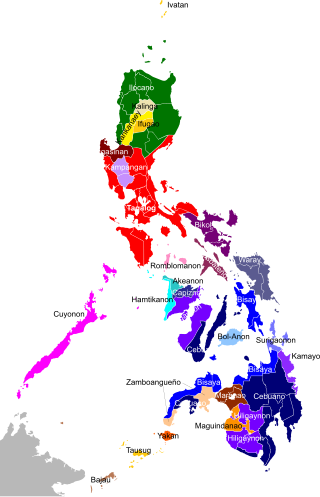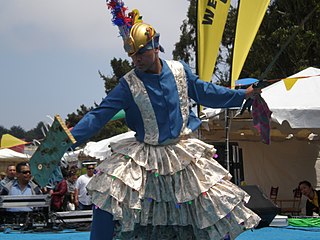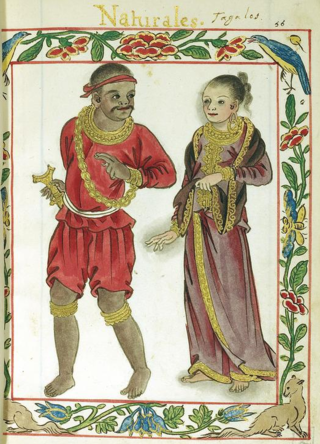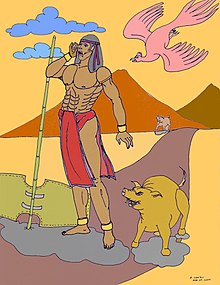
Ifugao, officially the Province of Ifugao, is a landlocked province of the Philippines in the Cordillera Administrative Region in Luzon. Its capital is Lagawe and it borders Benguet to the west, Mountain Province to the north, Isabela to the east, and Nueva Vizcaya to the south.
Philippine literature is literature associated with the Philippines from prehistory, through its colonial legacies, and on to the present.

The kampilan is a type of single-edged sword, traditionally used by various ethnic groups in the Philippine archipelago. It has a distinct profile, with the tapered blade being much broader and thinner at the point than at its base, sometimes with a protruding spikelet along the flat side of the tip. The design of the pommel varies between ethnic groups, but it usually depicts either a buaya (crocodile), a bakunawa, a kalaw (hornbill), or a kakatua (cockatoo)..

The Maranao people, also spelled Meranaw, Maranaw, and Mëranaw, is a predominantly Muslim Filipino ethnic group native to the region around Lanao Lake in the island of Mindanao. They are known for their artwork, weaving, wood, plastic and metal crafts and epic literature, the Darangen. They are ethnically and culturally closely related to the Iranun people and Maguindanao people, all three groups being denoted speaking Danao languages and giving name to the island of Mindanao. They are grouped with other Moro people due to their shared religion.

Philippine mythology is rooted in the many indigenous Philippine folk religions. Philippine mythology exhibits influence from Hindu, Muslim, Buddhist, and Christian traditions.

Biag ni Lam-ang is an epic story of the Ilocano people from the Ilocos region of the Philippines. It is notable for being the first Philippine folk epic to be recorded in written form, and was one of only two folk epics documented during the Philippines' Spanish Colonial period, along with the Bicolano epic of Handiong. It is also noted for being a folk epic from a "Christianized" lowland people group, with elements incorporated into the storytelling.

The Philippines is inhabited by more than 182 ethnolinguistic groups, many of which are classified as "Indigenous Peoples" under the country's Indigenous Peoples' Rights Act of 1997. Traditionally-Muslim peoples from the southernmost island group of Mindanao are usually categorized together as Moro peoples, whether they are classified as Indigenous peoples or not. About 142 are classified as non-Muslim Indigenous people groups, and about 19 ethnolinguistic groups are classified as neither Indigenous nor Moro. Various migrant groups have also had a significant presence throughout the country's history.

The Bicolano people are the fourth-largest Filipino ethnolinguistic group. Their native region is commonly referred to as Bicolandia, which comprises the entirety of the Bicol Peninsula and neighboring minor islands, all in the southeast portion of Luzon. Males from the region are often referred to as Bicolano, while Bicolana may be used to refer to females.
The Karay-a are a Visayan ethnic group native to the islands of Panay and Palawan in the Philippines. They speak the Karay-a language.

Hinilawod is an epic poem orally transmitted from early inhabitants of a place called Sulod in central Panay, Philippines. The term "Hinilawod" generally translates to "Tales From The Mouth of The Halawod River". The epic must have been commonly known to the Visayans of Panay before the conquest, since its main protagonists, like Labaw Donggon, were noted in the accounts of the Islanders' beliefs and recorded by early Spanish colonizers. One of these Westerners' accounts says that the adventures of this ancient hero of Panay were recalled during weddings and in songs. It was noted that there were still native Mundos of Dingle, Iloilo who worshipped Labaw Donggon even until the last years of the Spanish rule in the Philippines. These worshippers would stealthily enter a certain cave in Dingle in the evening of a certain day of the year, in order to render homage and to offer poultry, doves, rice, bananas, and pigs to the ancient Visayan god.

Singkil is an ethnic dance of the Philippines that has its origins in the Maranao people of Lake Lanao, a Mindanao Muslim ethnolinguistic group. The dance is widely recognized today as the royal dance of a prince and a princess weaving in and out of crisscrossed bamboo poles clapped in syncopated rhythm. While the man manipulates a sword and shield, the woman gracefully twirls a pair of fans. The dance takes its name from the belled accessory worn on the ankles of the Maranao princess. A kulintang and agung ensemble always accompanies the dance. Singkil has evolved over time, with significant reinterpretations and changes introduced by the Bayanihan folk dance group, such as the incorporation of the elements from the Darangen epic, particularly the episodes involving Prince Bantugan and Princess Gandingan.

Sagayan is a Philippine war dance performed by Maguindanao, Maranao, and Iranun depicting in dramatic fashion the steps their hero, Prince Bantugan, took upon wearing his armaments, the war he fought in and his subsequent victory afterwards. Performers, depicting fi,erce warriors would carry shields with shell noisemakers in one hand and a kampilan sword in the other attempting rolling movements to defend their master.
Felipe Landa Jocano was a Filipino anthropologist, educator, and author known for his significant body of work within the field of Philippine Anthropology, and in particular for documenting and translating the Hinilawod, a Western Visayan folk epic. His eminence within the field of Philippine anthropology was widely recognized during his lifetime, with National Artist F. Sionil Jose dubbing him "the country's first and foremost cultural anthropologist"
The arts in the Philippines reflect a range of artistic influences on the country's culture, including indigenous art. Philippine art consists of two branches: traditional and non-traditional art. Each branch is divided into categories and subcategories.

Darangen is a Maranao epic poem from the Lake Lanao region of Mindanao, Philippines. It consists of 17 cycles with 72,000 lines in iambic tetrameter or catalectic trochaic tetrameter. Each cycle pertains to a different self-contained story. The most notable of which deals with the exploits of the hero Bantugan.

Ibalon, or Ibalong, is the ancient name of the Bicol Region in the Philippines. The center of settlement is believed to be either beside the Bicol River at present-day Libmanan, Camarines Sur or in Magallanes, Sorsogon, Philippines, renowned as one of the first Spanish settlements in the island of Luzon. At some point, the name Ibalong was also used by the Spanish to refer to the entire Bicol Peninsula and, to some extent the entire island of Luzon.
Intangible cultural heritage (ICH) includes traditions and living expressions that are passed down from generation to generation within a particular community.

The Ibálong, also known as Handiong or Handyong, is a 60-stanza fragment of a Bicolano full-length folk epic of the Bicol region of the Philippines, based on the Indian Hindu epics Ramayana and Mahabharata. The epic is said to have been narrated in verse form by a native bard called Kadunung.
"Hudhud ni Aliguyon" stands as a renowned epic originating from the Ifugao province, located on the island of Luzon within the Philippines. This epic serves as a comprehensive narrative, offering insights into the cultural and traditional facets intrinsic to the Ifugao community, alongside chronicling the heroic exploits of their revered figure, Aliguyon. Classified within the genre of "Hudhud di Ani," intended for recitation during the agricultural harvest season, this epic fulfills a multifaceted role characterized by three distinct functions.











